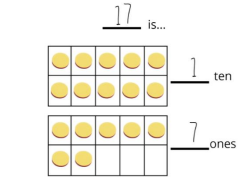General Information
Benchmark Instructional Guide
Connecting Benchmarks/Horizontal Alignment
Terms from the K-12 Glossary
- Equation
- Expression
Vertical Alignment
Previous Benchmarks
Next Benchmarks
Purpose and Instructional Strategies
The purpose of this benchmark is to help students build the foundation of place value. By decomposing and viewing a number as its 10s and 1s students can begin to use strategies for adding and subtracting in later benchmarks and grade levels as the scale increases.- Instruction helps students develop the meaning of numbers beyond the conventional names.
- Instruction focuses on multiple ways to represent numbers (MTR.2.1).
- Instructions build the foundation for expanded form and decomposing numbers, which can be used as a strategy for operations later (MTR.5.1).
Common Misconceptions or Errors
- Students may attach too much meaning to certain number names. Example: sixteen linguistically makes sense as six and teen, or six and ten; while eleven and twelve do not have linguistic cues.
- Students may think there is only one way to represent numbers with tens and ones.
Strategies to Support Tiered Instruction
- Teacher provides opportunities to count collections of objects that contain sets with quantities between 11 and 20, using one ten frame to isolate the idea that the quantity contains “ten and some more.”
- For example, students can count the objects that are placed in the ten frame with a “count on” strategy, “10...11, 12, 13, 14.” Using a ten frame reinforces the idea that 10 is a benchmark number and that “10 and more” can be counted additively (10+1+1+1+1) rather than by single units. Students can communicate their thinking by drawing representations of their counts and explaining each drawing. Instruction should emphasize that the “1” in teen numbers means “10,” and language support can include students rephrasing teen number words, for example, “16 is the same as 10 and 6.”

Instructional Tasks
Instructional Task 1(MTR.1.1, MTR.4.1)
Materials: Counters and ten framesTask: Give students two ten frames and a number of counters between 11 and 19. Students will fill a 10 frame, and fill the second with the left over counters. Have students record the number of tens and ones like the example below. This task can be done in a small group, providing opportunities for discussion and collaboration.

Instructional Items
Instructional Item 1
Given the following, fill in the blanks. For the first two, have students provide a different way to fill in the blanks. Students should give more than one answer when possible.
